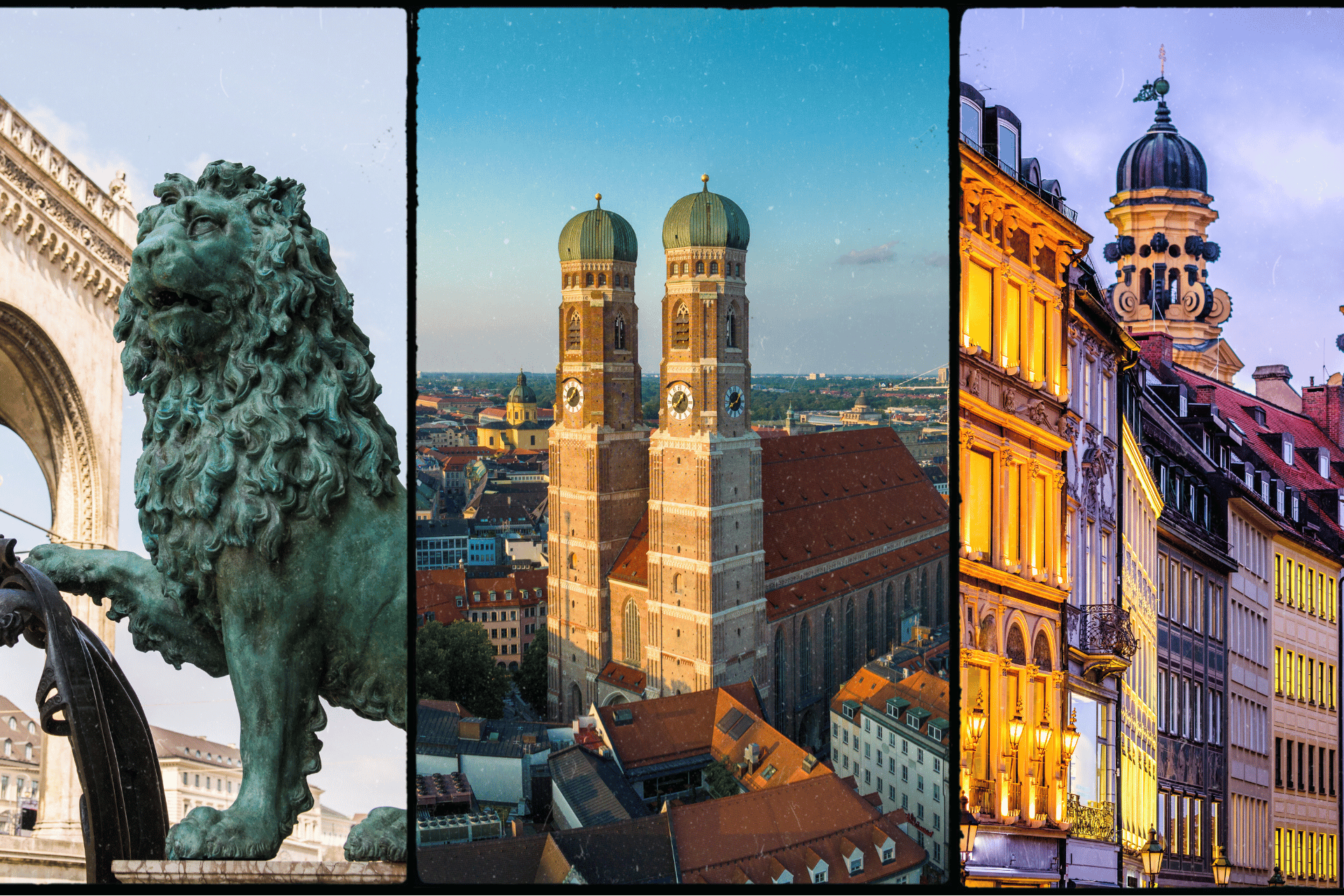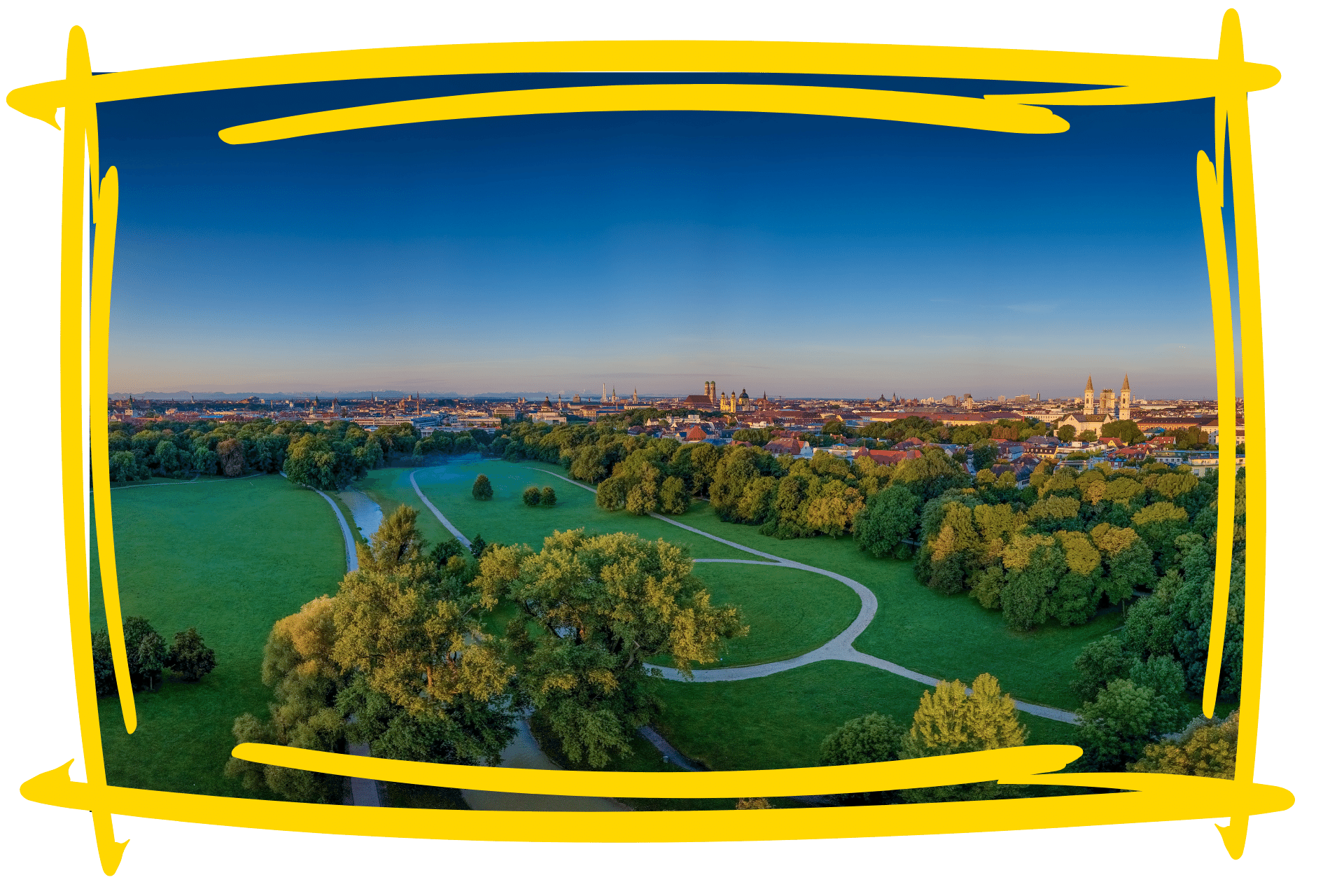Headed to Germany for EURO 2024? Ahead of the tournament this summer, which’ll see matches played across the country from the Olympiastadion in Berlin to the Volksparkstadion in Hamburg, we’re putting together quick guides to the host cities to help you figure out what to do when you’re not watching the footie.
Our first stop was Berlin, and this week we’re heading to Munich. Our quick guide will give you an idea of the must-do’s down to the must-eats, perfect for a quick break in the city.
The must do’s
There’s a lot of the old here (think palaces, gargoyled town halls, and Bavarian beer halls) but there’s also a surprising amount of the new too.
The Old Town
The Old Town is the historic core of the city and home to many of the local landmarks, like Marienplatz – Munich’s central square and it’s natural meeting point. It’s where you’ll find the Altes Rathaus and the Neus Rathaus (that’s the Old and New Town Hall, to you and me). One fairy-tale like and the other adorned by gargoyles, the Neus Rathaus is home to the famous Glockenspiel, where if you look up at at 11am, noon and 5pm (from March to October), you’ll spot its colourful figures depicting the city’s history pop out to the chime of bells.
The Old Town is also where you’ll find the Frauenkirche (Cathedral of Our Lady), an iconic symbol of Munich with its twin onion-domed towers, as well as Hofbräuhaus, one of the oldest beer halls in the city, and the Viktualienmarkt, a famous daily food market that’s been in operation since the 19th century.
Schloss Nymphenburg
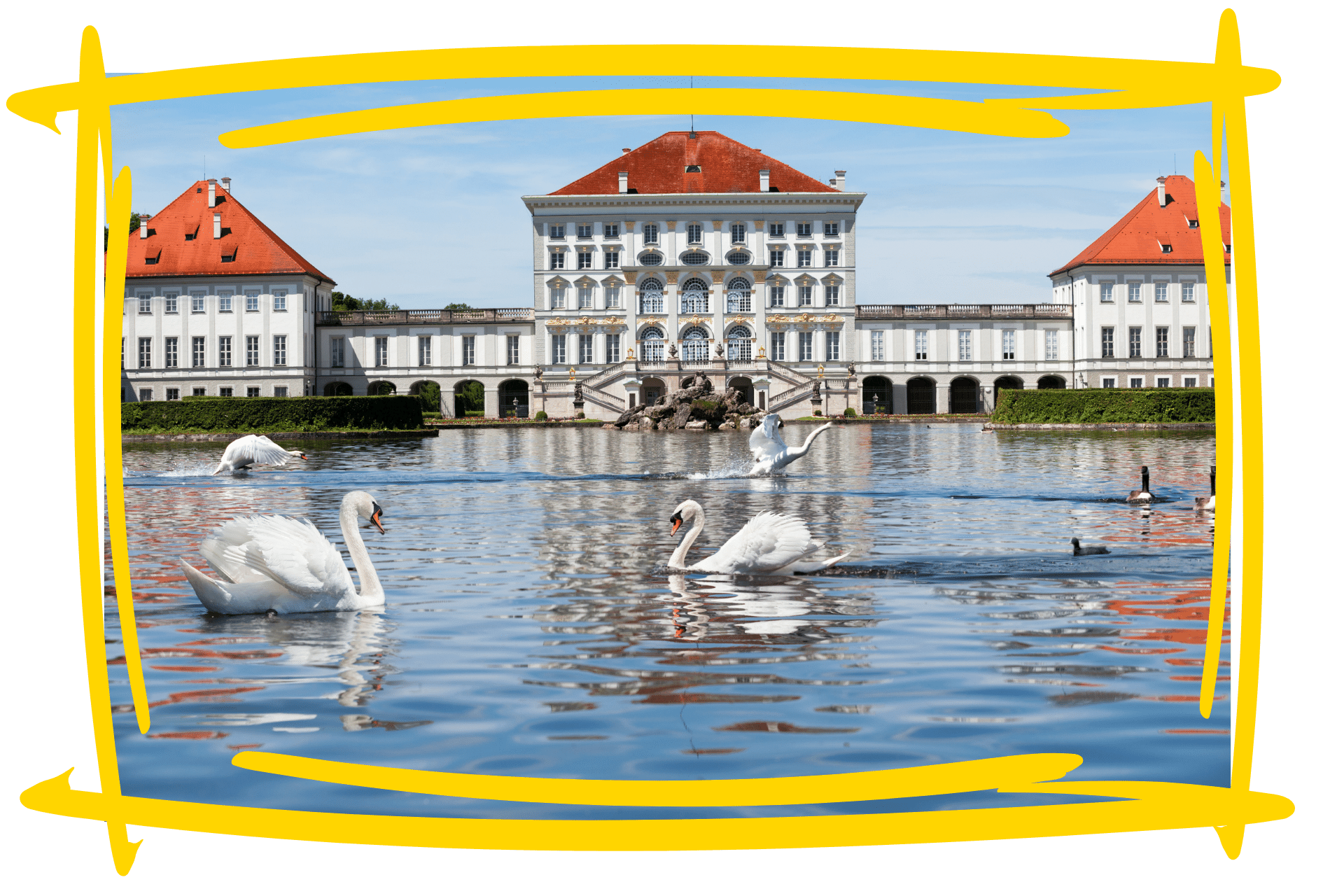 If you like the finer things, make a stop here. With mega grand interiors and huge grounds, Schloss Nymphenburg was initially just a villa which then expanded into a full on summer residence for the royal family.
If you like the finer things, make a stop here. With mega grand interiors and huge grounds, Schloss Nymphenburg was initially just a villa which then expanded into a full on summer residence for the royal family.
The main palace consists of a villa and two large wings, where you can see the world’s largest collection of porcelain from the famous Nymphenburger Manufaktur… or the Schönheitengalerie in the former apartments of Queen Caroline, home to some 38 portraits of attractive females cherry-picked by an admiring King Ludwig I to peer prettily at him from the walls.
The palace grounds, meanwhile, are perfect for whiling away the afternoon. Laid out in grand English style, it’s got a big lake, a cascade and a canal – being summer you won’t be able to ice skate here, but you can feed the swans, at least.
BMW Museum
One for the petrol heads, the BMW Museum is housed in a building lovingly referred to as the ‘Weisswurstkessel’ – the sausage pot – and tells the story of the vehicle manufacturer across 125 exhibits, from cars to motorbikes to engines.
The collection here includes the BMW 750iL from the 1997 Bond film “Tomorrow Never Dies”, the BMW Isetta, and cars from the BMW Art Car Collection – and you can see at least one of these on display at the museum at all times.
Right next door is the BMW Welt which is a mega futuristic building all about BMW now – this is where you can see their latest models and even gain access to a view of the ‘premiere’ – the bit where customers say hello to their shiny new cars for the first time. Your dad will say it was like seeing you come out in the delivery room.
Englischer Garten
The Englischer Garten is massive – like one-of-the-largest-urban-parks-in-the-world massive. Over 910 acres, all in.
It’s known for its mega pretty landscapes, meandering streams, and huge lawns, making it a fave summer spot for both locals and tourists. Besides lolling on the grass, you can also see the Japanese Teahouse, the Chinese Tower beer garden, and the Eisbach River here, where surfers ride the standing wave year-round. We reckon the best way to see the park is to hop on a rented bike for a couple of hours – your feet will thank us.
Where to grab a pint
In lieu of Oktoberfest (which actually happens in November, but still doesn’t help you as you’ll be here in summer – boo!), try these places.
Beer gardens
If you’re in town for EURO 2024, then you’ll be after a pint (or several) at some point. And what with it being beer garden season, you’ll be after one of those too.
Biergarten at Viktualienmarkt
Found among the vibrant stalls of Viktualienmarkt in the Old Town, which sell everything from fresh produce to fancy gourmet delicacies, the Biergarten (probs the easiest bit of German you’ll ever learn) is unique in that it serves beers from all six of Munich’s major breweries on a rotating basis, giving you the chance to have a proper sampling of the city’s rich brewing heritage. Think: lots of long communal tables shaded by chestnut trees. You can bring your own food or purchase traditional Bavarian nosh from nearby vendors.
Chinese Tower Biergarten
In the heart of the sprawling Englischer Garten, the Chinese Tower Biergarten is one of the city’s most beloved beer gardens. Dominated by the striking, pagoda-like Chinese Tower, this biergarten can fit up to a whopping 7,000 guests, making it one of the largest in Munich. You can enjoy a wide range of traditional Bavarian beers and dishes such as pretzels, sausages, and roast pork, all while sitting under the shade of ancient chestnut trees. Plus brass bands often provide some traditional Bavarian music from the tower’s second floor.
Beer halls
Munich is the capital of Bavaria, so they really know how to do a beer hall here. They can be touristy, but they’re still a solid shout for food and drink at a reasonable price. Brace for a very lively atmosphere, especially on Fridays and at the weekend.
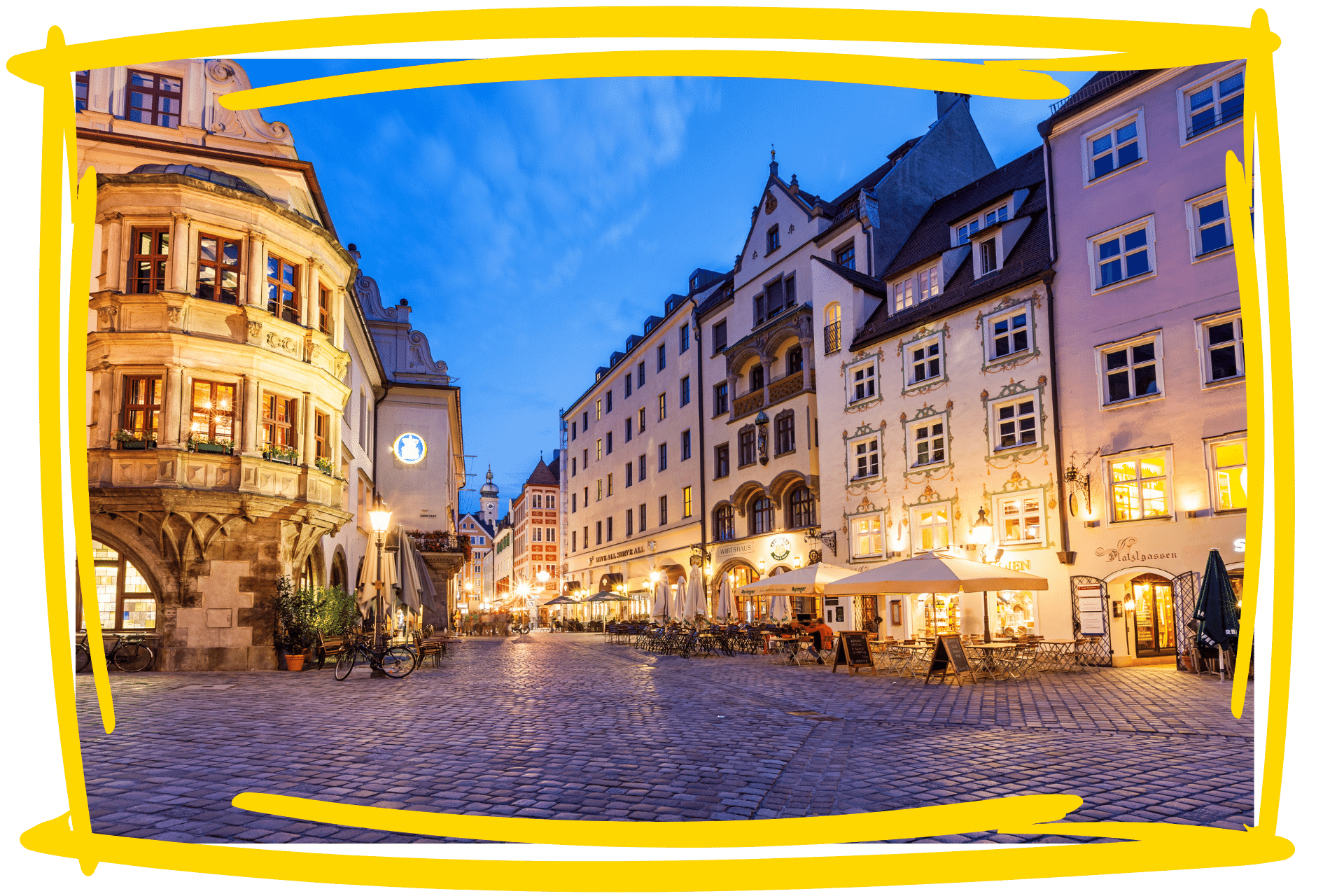 Hofbräuhaus
Hofbräuhaus
Definitely high on the tourist radar but still a classic experience in Munich, the Hofbräuhaus is one of the world’s most famous beer halls, absolutely chock-full of history and Bavarian tradition. Established in 1589 by Duke Wilhelm V to supply the royal court with quality beer, you’ll find it in the Old Town, just a short walk from Marienplatz.
Picture grand, vaulted halls and lots of traditional Bavarian decor, with long wooden tables and often live music from local brass bands. They serve a variety of their own brews, including the famous Hofbräu Original, Dunkel, and seasonal specialties like Maibock, and you can also enjoy hearty Bavarian cuisine, like pretzels, sausages, pork knuckles, and sauerkraut. It’s had some famous folks visit over the years, including Mozart and even Vladimir Lenin.
Augustiner-Keller
Another of the city’s oldest and most cherished beer gardens, but slightly less frequented by tourists, Augustiner-Keller has been around since 1812. Located near Munich’s central train station, it’s known for its large outdoor seating area where, again, the ambiance is quintessentially Bavarian, with long wooden tables and benches.
Inside is where you’ll find the cosy beer hall, where you can enjoy freshly tapped beers from wooden barrels, with Augustiner, Munich’s oldest independent brewery founded in 1328, providing a variety of traditional brews. The menu features classic Bavarian dishes, and there’s also live traditional music performed here too.
Munich munchies
Like Berlin, food here has an emphasis on the hearty and the delicious, and always comes with a round of beer. This is Bavaria!
Müncher Weiβwurst
Müncher Weiβwurst, or Munich white sausage, is made primarily from finely minced veal and fresh pork back bacon, and then flavoured with a mix of parsley, lemon, mace, onions, ginger, and cardamom. Typically enjoyed as a mid-morning snack, it’s traditionally served in a bowl of hot water to keep it warm and accompanied by freshly baked pretzels, sweet mustard, and a nice, cold glass of Bavarian wheat beer. Don’t forget to do the “zuzeln” – suck the meat out of the casing, and you’ll be a proper Münchner.
Bavarian pretzel
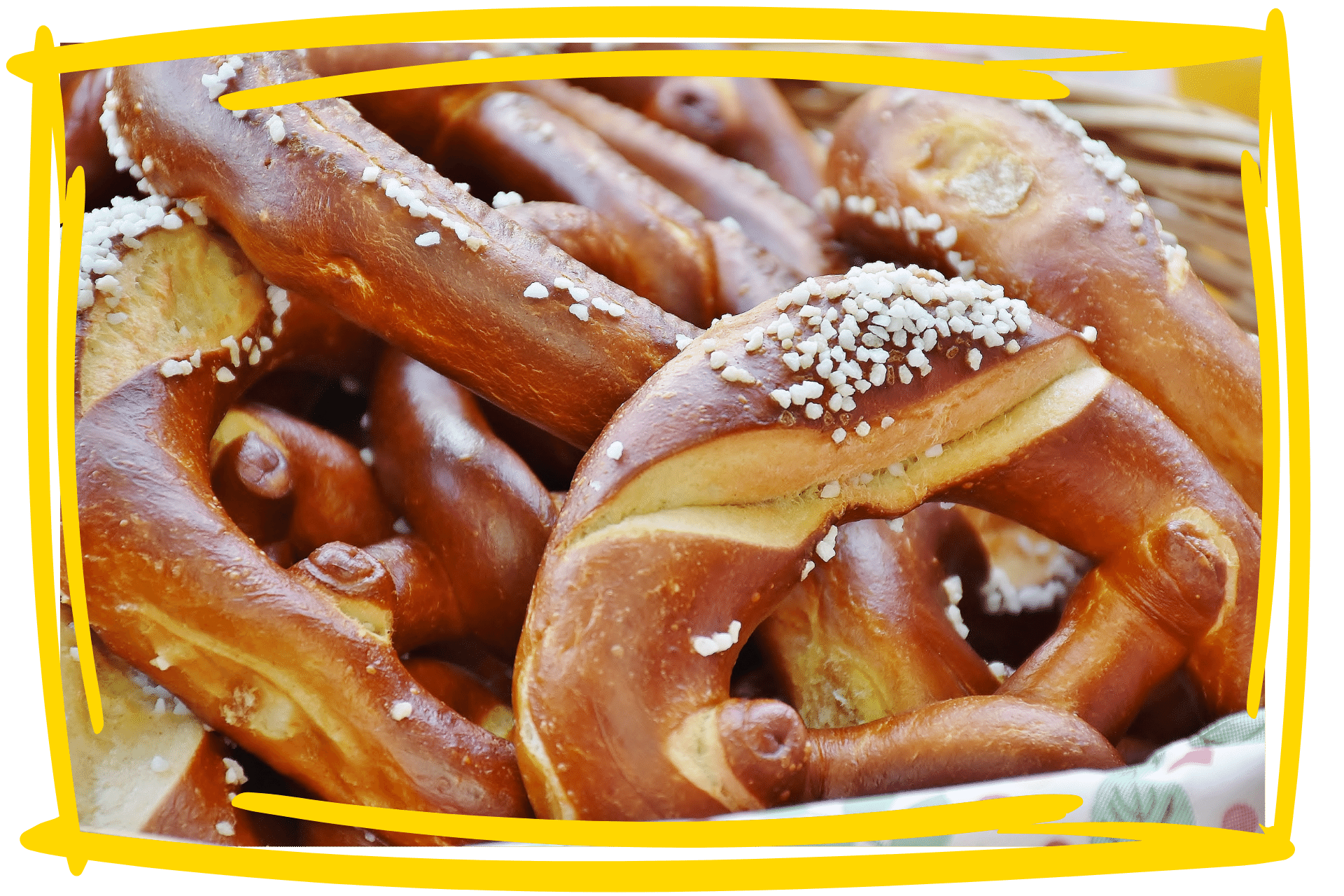 The Bavarian pretzel, or “Brezn” as it is locally known, looks just like a normal pretzel, but what makes it Bavarian is dipping the dough into a lye solution before baking. This lye bath, or “Laugenbad,” reacts with the dough during baking to create that glossy, deep-brown crust and gives it that unique taste. A staple at beer gardens and Oktoberfest, they’re often paired with cheese spreads (Obatzda), and, of course, a refreshing mug of beer. An all-rounder, locals enjoy them for breakfast, lunch, and as an easy snack.
The Bavarian pretzel, or “Brezn” as it is locally known, looks just like a normal pretzel, but what makes it Bavarian is dipping the dough into a lye solution before baking. This lye bath, or “Laugenbad,” reacts with the dough during baking to create that glossy, deep-brown crust and gives it that unique taste. A staple at beer gardens and Oktoberfest, they’re often paired with cheese spreads (Obatzda), and, of course, a refreshing mug of beer. An all-rounder, locals enjoy them for breakfast, lunch, and as an easy snack.
Spaetzle
This beloved type of egg noodle is known for its soft, chewy texture and versatile nature, making it a staple in many German kitchens. The name “Spaetzle” is actually derived from the Swabian word for “little sparrows,” – a nod to their irregular, whimsical shape. A popular version of it is Käsespätzle, where the noodles are layered with grated cheese (typically Emmental or Gruyère) and topped with crispy fried onions, then baked until bubbly and golden. Think of it as Germany’s answer to mac ‘n’ cheese. Basically, it’s the ultimate Bavarian comfort food.
Day trips from Munich
Munich is perfectly placed for quick trip out of the city, and even out of the country if you fancy ticking off another one!
Augsburg
Distance from Munich: 30 minutes by train
If you love Munich’s history, you’ll love Augsburg, one of the country’s oldest cities. Founded by the Romans in 15 BC as Augusta Vindelicorum, over the centuries it flourished, particularly during the Renaissance when it became a hub of commerce, finance, and culture under the influence of the powerful Fugger banking family. This period saw the construction of many of the city’s iconic buildings, such as the Augsburg Town Hall and the Perlachturm, still key landmarks today.
The city is known for its beautiful architecture, from the Renaissance splendour of its old town to the well-preserved medieval streets and buildings. Visitors can explore the Fuggerei, the world’s oldest social housing complex still in use, as well as a lively arts scene, with numerous museums, galleries, and theatres. Then there’s Augsburg’s green spaces, such as the Augsburg Botanical Garden and the Siebentischwald forest, offering up peaceful retreats within the city.
Schloss Neuschwanstein
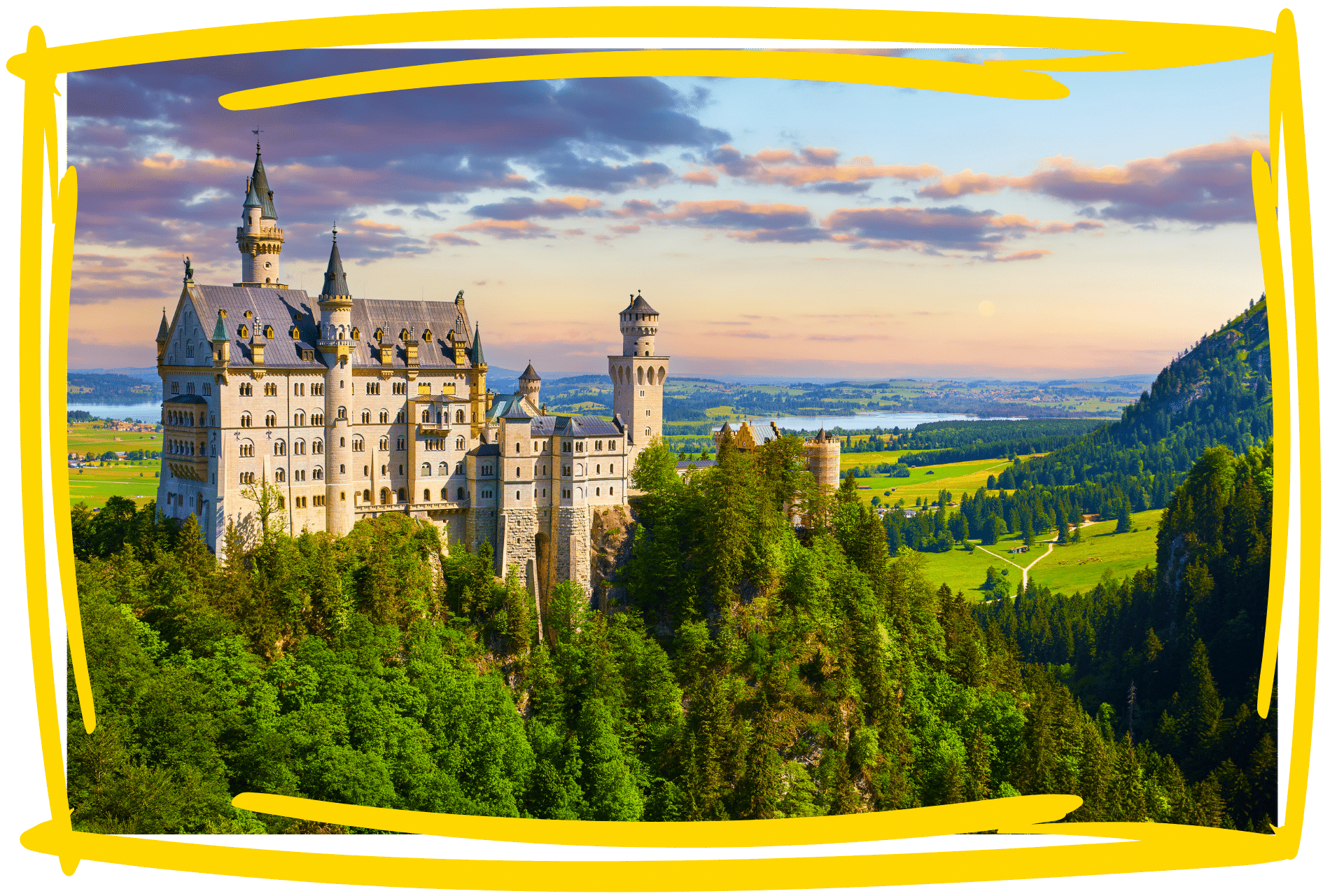 Distance from Munich: under 2 hours by express train, plus an 8 minute bus ride from the local town of Füssen
Distance from Munich: under 2 hours by express train, plus an 8 minute bus ride from the local town of Füssen
You’ll have seen this place before, and always wondered where it actually was. Schloss Neuschwanstein, AKA the Walt Disney castle and located in the Bavarian Alps, is one of the most famous castles in the world. Commissioned by the so-called ‘mad’ King Ludwig II of Bavaria in 1869, the castle was built as a homage to the operas of Richard Wagner, whom Ludwig was a massive fan of. King Ludwig II died under mysterious circumstances in 1886 before the castle was completed and, today the castle is a mahoosive tourist attraction.
Perched on a rugged hilltop surrounded by dense forests and overlooking a valley, it’s said to be Walt Disney’s inspiration for Sleeping Beauty’s castle. Inside, the interiors are mega opulent. Think: intricate woodwork, elaborate frescoes depicting scenes from Wagner’s operas, and luxurious furnishings. Highlights include the Throne Room, designed to resemble a Byzantine basilica, and the Singers’ Hall, which was intended for musical performances that never ended up happening.
Salzburg, Austria
Distance from Munich: 1 hour 30 minutes on the Railjet high-speed train
Fancy squeezing in another country whilst you’re there? Salzburg, Austria, nestled on the banks of the Salzach River and surrounded by the majestic Eastern Alps, is a city renowned for its stunning baroque architecture, rich cultural heritage, and musical legacy – and it’s a dead easy train trip away from Munich! With a beautifully preserved old town (officially a UNESCO World Heritage Site), the city’s skyline is dominated by the imposing Hohensalzburg Fortress, one of the largest and best-preserved medieval castles in Europe.
Famously the birthplace of Mozart, you can explore his birthplace and residence, both now museums dedicated to his life and work. Plus there’s the renowned Salzburg Festival, an annual event that attracts world-class performers across opera, drama, and classical music. There’s also a pretty vibrant cultural scene here, with loads of art galleries and theatres to check out. For some greenery, head to Mirabell Palace and Gardens, with its baroque architecture and beautifully landscaped grounds.
How to get around Munich
Getting around the city is easy, and the fare is the same for any type of public transport you use, whether train, tram, or bus.
By train
Using the U-Bahn
Munich’s underground railway network, the U-Bahn has 8 lines serving almost 100 different stations around the city. Operating daily from 4:15 am to 1 am, trains run every 5 to 10 minutes. On Fridays, Saturdays and the nights before public holidays, trains run all through the night.
The M Zone, which covers the city centre, will get you to most of the sites you want to see.
Using the S-Bahn
The S-Bahn is Munich’s urban rail network. Its 8 lines and 150 stations cover the entire metropolitan area, as well as the airport. Operating daily from approximately 4:15 am to 1 am, trains run every 10 minutes in rush hour and every 20 minutes at other times. At night, trains depart every 20 to 40 minutes. On Fridays, Saturdays and the nights before public holidays, trains run all through the night.
By tram
Munich’s trams are spread across 13 daytime train lines and 4 nighttime lines, covering a total of 165 stops throughout Munich. Certain tram lines will be particularly useful to you, such as tram line 19, which passes many central attractions including Karlsplatz, Marienplatz, and the Bavarian National Museum.
Understanding the fares
Tickets for Munich’s public transport network are the same no matter which type you use. Prices range from €2.90 for a single ticket covering one zone, and up to €11.60 for use of all 4 of the city’s zones – but you’ll find that most tourist attractions are located within zone 1, so if you stay within that area, you’ll only need the cheapest ticket.
Children between 6 and 14 years old only pay € 1.80 per journey – no matter how long the trip is.
For a full breakdown on ticket prices, click here.
How to get to the Allianz Stadium in Munich for EURO 2024
If you travel by U-Bahn, the easiest way is to head to Marienplatz and from there take the U6 Line heading towards Garching-Forschungszentrum. Stay on the U6 line for approximately 16-18 minutes until you reach Fröttmaning station, and then it’s around a 10-15 minute, well-signposted, walk from there to the Allianz Stadium.
On match days, the U-Bahn can be very crowded, so plan to leave early to avoid the rush.

